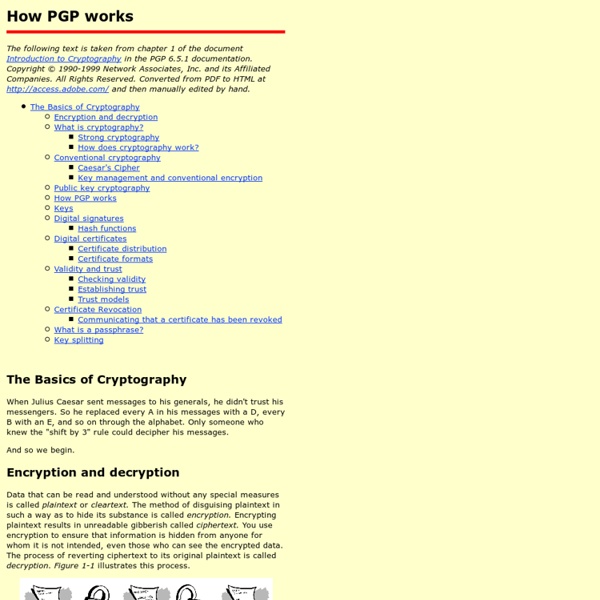Prime Number Hide-and-Seek: How the RSA Cipher Works
Preface: What is This? The RSA cipher is a fascinating example of how some of the most abstract mathematical subjects find applications in the real world. Few are the mathematicians who study creatures like the prime numbers with the hope or even desire for their discoveries to be useful outside of their own domain. But every now and then that is exactly what happens. This text explains the mathematics behind RSA -- how and why it works. The most important mathematical facts necessary for understanding RSA's foundations are reviewed near the beginning. In one or two places, I have specifically targeted an explanation to what I consider to be the average computer programmer, leveraging analogous concepts in programming and general mathematics. Before getting started, I should make some observations on the mathematical notation used here. Introduction: The Idea of a Trapdoor Function What a mathematician refers to as a is very similar to a function in computer programming. x == bar(foo(x)) or:
Peer-to-peer SIP
Peer-to-peer SIP (P2P-SIP) is the implementation of a distributed Voice over Internet Protocol (VoIP) or instant messaging communications application using a peer-to-peer (P2P) architecture in which session or call control between communication end points is facilitated with the Session Initiation Protocol (SIP). In a pure peer-to-peer application architecture no central servers are required,[1] whereas traditional SIP telephony networks have relied on the client–server model of computing[2] using centrally deployed and managed SIP servers.[3] P2P application design can improve scalability[4] and survivability in the event of central network outages. Based on these inherent SIP features it is possible to construct a peer-to-peer network of SIP nodes (P2P over SIP). See also[edit] References[edit] External links[edit] A code library for P2P over SIP: Sip2Peer project.
Public Keys and Private Keys - How they work with Encryption | Comodo
The Public and Private key pair comprise of two uniquely related cryptographic keys (basically long random numbers). Below is an example of a Public Key: The Public Key is what its name suggests - Public. Because the key pair is mathematically related, whatever is encrypted with a Public Key may only be decrypted by its corresponding Private Key and vice versa. For example, if Bob wants to send sensitive data to Alice, and wants to be sure that only Alice may be able to read it, he will encrypt the data with Alice's Public Key. As only Alice has access to her Private Key, it is possible that only Alice can decrypt the encrypted data. Public Key Cryptography can therefore achieve Confidentiality.
SIP - Session Initiation Protocol
SIP works in conjunction with several other application layer protocols that identify and carry the session media. Media identification and negotiation is achieved with the Session Description Protocol (SDP). For the transmission of media streams (voice, video) SIP typically employs the Real-time Transport Protocol (RTP) or Secure Real-time Transport Protocol (SRTP). For secure transmissions of SIP messages, the protocol may be encrypted with Transport Layer Security (TLS). History[edit] The protocol was designed with the vision to support new multimedia applications. SIP is distinguished by its proponents for having roots in the Internet community rather than in the telecommunications industry. Protocol operation[edit] SIP employs design elements similar to the HTTP request/response transaction model.[8] Each transaction consists of a client request that invokes a particular method or function on the server and at least one response. Network elements[edit] User agent[edit] Registrar[edit]
Iptables Tutorial 1.2.2
I would like to dedicate this document to my wonderful sister, niece and brother-in-law for giving me inspiration and feedback. They are a source of joy and a ray of light when I have need of it. Thank you! A special word should also be extended to Ninel for always encouraging my writing and for taking care of me when I needed it the most. Second of all, I would like to dedicate this work to all of the incredibly hard working Linux developers and maintainers. Iptables is an extremely knowledge intensive tool. This chapter aims at explaining the pure "must understands" of TCP/IP before you can go on and work with iptables. Iptables is also able to work on higher layers, such as the Application layer. TCP/IP Layers TCP/IP is, as already stated, multi-layered. The biggest reason is that the whole architecture is very extensible. There are two basic architectures to follow when talking about layers. Application layer Transport layer Internet layer Network Access layer Attn: John Doe V.
XMPP
Communications protocol for message-oriented middleware Extensible Messaging and Presence Protocol (XMPP, originally named Jabber[1]) is an open communication protocol designed for instant messaging (IM), presence information, and contact list maintenance.[2] Based on XML (Extensible Markup Language), it enables the near-real-time exchange of structured data between two or more network entities.[3] Designed to be extensible, the protocol offers a multitude of applications beyond traditional IM in the broader realm of message-oriented middleware, including signalling for VoIP, video, file transfer, gaming and other uses. Originally developed by the open-source community, the protocols were formalized as an approved instant messaging standard in 2004 and have been continuously developed with new extensions and features. Protocol characteristics[edit] Decentralization[edit] Addressing[edit] Since a user may wish to log in from multiple locations, they may specify a resource. Features[edit]
File:Netfilter-packet-flow.svg
Cancel Edit Delete Preview revert Text of the note (may include Wiki markup) Could not save your note (edit conflict or other problem). Upon submitting the note will be published multi-licensed under the terms of the CC-BY-SA-3.0 license and of the GFDL, versions 1.2, 1.3, or any later version. Add a note Draw a rectangle onto the image above (press the left mouse button, then drag and release). Save To modify annotations, your browser needs to have the XMLHttpRequest object. [[MediaWiki talk:Gadget-ImageAnnotator.js|Adding image note]]$1 [[MediaWiki talk:Gadget-ImageAnnotator.js|Changing image note]]$1 [[MediaWiki talk:Gadget-ImageAnnotator.js|Removing image note]]$1
Do not use XMPP
SSL Comparison and Reviews for Finding the Best SSL Certificate



